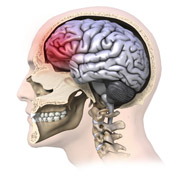Research and Innovation, UNL Office of

Center for Brain, Biology, and Behavior: Faculty Publications
Reappraisal-related downregulation of amygdala BOLD activation occurs only during the late trial window
Document Type
Article
Date of this Version
2022
Citation
Cognitive, Affective, & Behavioral Neuroscience (2022) 22:777–787
doi:10.3758/s13415-021-00980-z
PMC9256861
Abstract
During cognitive reappraisal, an individual reinterprets the meaning of an emotional stimulus to regulate the intensity of their emotional response. Prefrontal cortex activity has been found to support reappraisal and is putatively thought to downregulate the amygdala response to these stimuli. The timing of these regulation-related responses during the course of a trial, however, remains poorly understood. In the current fMRI study, participants were instructed to view or reappraise negative images and then rate how negative they felt following each image. The hemodynamic response function was estimated in 11 regions of interest for the entire time course of the trial including image viewing and rating. Notably, within the amygdala there was no evidence of downregulation in the early (picture viewing) window of the trial, only in the late (rating) window, which also correlated with a behavioral measure of reappraisal success. With respect to the prefrontal regions, some (e.g., inferior frontal gyrus) showed reappraisal-related activation in the early window, whereas others (e.g., middle frontal gyrus) showed increased activation primarily in the late window. These results highlight the temporal dynamics of different brain regions during emotion regulation and suggest that the amygdala response to negative images need not be immediately dampened to achieve successful cognitive reappraisal.


Comments
Free access at PubMed Central https://www.ncbi.nlm.nih.gov/pmc/articles/PMC9256861/pdf/13415_2021_Article_980.pdf
© The Author(s) 2022